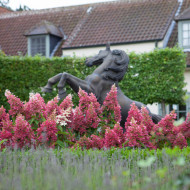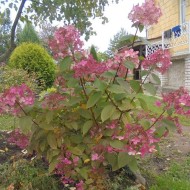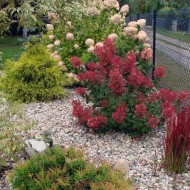How to grow a panicle hydrangea variety Weems Red in the country
Content
Features of hydrangea Weems Red
Europeans got acquainted with the flower culture of hydrangea (Latin name Hydrangea paniculata) in the 18th century, when it was brought by the English botanist D. Banks, who visited China. However, it took almost two centuries before the massive popularity of color. At the beginning of the last century, breeders got down to business, and soon the number of new varieties and hybrids exceeded a hundred.
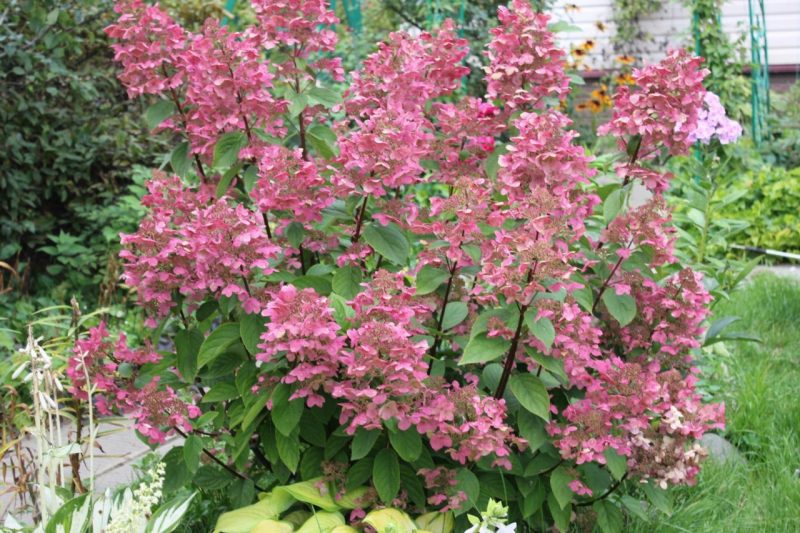
Vims Red (Red Wims) appeared recently, the author of the culture was the German botanist Wim Rutten. The main advantage of the flower is its unusually early flowering, which is much ahead of other varieties of hydrangeas in terms of timing.
Shrub description
Botanists describe Weems Red as a deciduous, picturesque flowering shrub. Here are the main features:
- Compact dimensions. Stems are not higher than 1.5–2 m. The shrub is capable of actively expanding in breadth.
- Uniform growth. Formative pruning gives the shrub a beautiful ball shape.
- Branches are claret-red, tough, withstand the weight of massive buds. They bend under the weight of the buds, but do not break.
- The foliage is elongated, dense, dark green, with noticeable veins. Located opposite. By autumn it changes color, becoming silvery-gold.
- During flowering, bolls with seeds suitable for planting are formed on the shoots.
Flowering period
Dissolving the first flowers at the end of June, the Weems Red hydrangea continues to bloom until late autumn. The buds are attractive looking, smell nice with honey notes. The flowers are small, sterile, united in massive pyramidal (20–35 cm long) inflorescences. During the growing season, they change color from white to pink, at the end of the season they become rich burgundy.
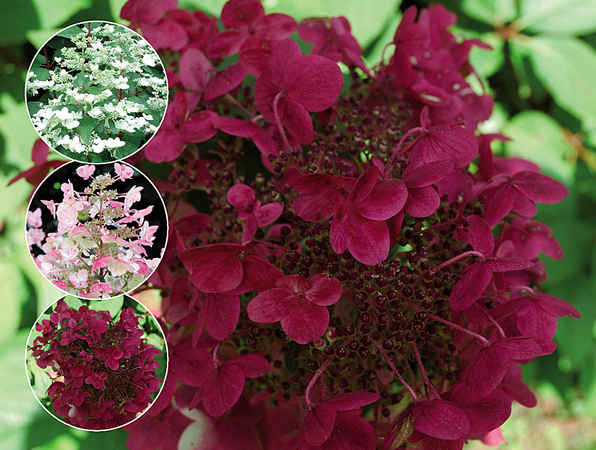
Advantages and disadvantages of the variety
The species is suitable for growing in all climatic conditions of the country.
- high winter hardiness (withstands frosts down to –30 ° С);
- unpretentious care;
- long and beautiful flowering;
- nice smell.
- average resistance to ailments;
- attractiveness to insect pests.
Video "Description of hydrangea Weems Red"
This video shows what an ornamental flowering shrub looks like.
Growing hydrangea Weems Red in the open field
The variety is long-lived. Once in favorable conditions, subject to the rules of agricultural technology, it is able to live and bloom profusely for about 40 years (some specimens live up to 60 years). Let's figure out what is needed for this.
- Plot decoration
- Solitary cultivation
- Mixborder element
Site and soil selection
Flowers need sun to grow, but enough diffused light. An area is suitable where the bushes remain in the shade for most of the day, for example, in the crowns of tall trees. However, it is better not to plant a hydrangea close to trees, since powerful rhizomes take a lot of moisture.The culture does not require abundant watering, it is enough to keep the soil moist. Wetlands or areas where moisture stagnates after precipitation are excluded for planting. In the wind, the flowers take root poorly, they easily lose foliage and inflorescences. It is advisable to choose a secluded, draft-free place.
The composition of the soil is selected following the rules:
- The best option is acidic and slightly acidic soils.
- Soil with neutral acidity will not allow the flowers to be saturated, the colors will be paler.
- Alkaline soils are not suitable for planting. In such soil, the bushes quickly stop growing, do not bloom, and soon die.
Landing dates and rules
You can plant Weems Red hydrangea in open ground in spring and autumn. The decision should be made depending on the climatic conditions:
- in northern latitudes, spring planting increases the chances of successfully taking root;
- in temperate and warm climates, an autumn planting is recommended, so that during the winter the plant hardens and starts active growth in the spring.
To avoid problems with cultivation, the seedlings are selected correctly. When examining, they pay attention that there are no spots, deposits, mechanical defects on the bark (fungi and viruses easily penetrate through the cracks).
The soil is prepared in advance - 2–3 weeks before planting, the site is dug up, then fertilized with peat, fallen leaves and sod land. If the soils are heavy, add sand.
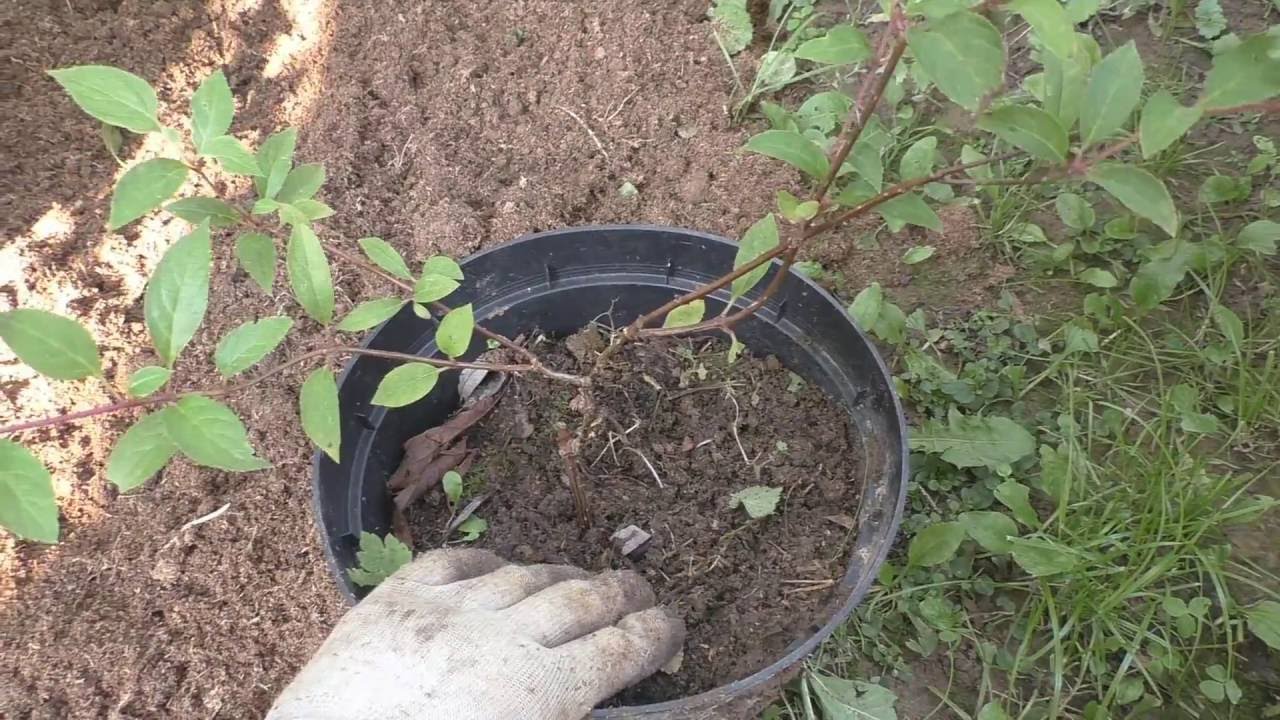
Agrotechnical rules for planting a flower culture are standard:
- They dig a planting hole 50x40 cm wide and deep. The main thing is that the root system of the seedling fits.
- The bottom, if necessary, is drained by adding a layer of small pebbles or pieces of brick.
- Fill in a third with a mixture of fertile soil. You can buy it in a specialty store or prepare it yourself by mixing garden soil, sand and humus in equal measure.
- The seedling is placed in a hole, the roots are straightened and added with the remaining soil substrate. Do not immerse deeply - the root collar should be on the surface.
- The site is watered with settled cold water, then loosened and mulched.
Plant care
The culture resists diseases well, easily tolerates cold. Caring for the bush is reduced to periodic watering, feeding and pruning.
The number of waterings depends on the weather. During the precipitation period, they are not required; on hot days, up to 30 buckets go to a square of shrubs. It is necessary to ensure that the root layer remains moist at all times.
Fertilizers are applied at certain periods:
- until mid-July - potassium or ammonium sulfate;
- in August - superphosphate.
Organic fertilizers are fine too. We recommend whey, which increases the acidity. Mulch (sawdust, foliage) will protect against excessive evaporation of water and cold snap. The soil is mulched immediately after planting the seedling. With the approach of winter, sanitary pruning is carried out: dry branches, defective shoots and dried inflorescences are removed.
In the middle lane, it is not necessary to cover the shrub, since the culture is frost-resistant. But in the northern regions, young seedlings are protected by raking up a layer of leaves, wrapping them with spruce branches or burlap.
Disease and pest control methods
The described variety most often suffers from chlorosis. For prevention, the plant:
- fed with a solution of salts with a high iron content;
- watered once every 15 days.
Sick bushes are fertilized with iron chelate - this will help them quickly recover. Fungal ailments are also dangerous. Appropriate fungicides are used against them. Insecticide "Aktara" helps well against pests.
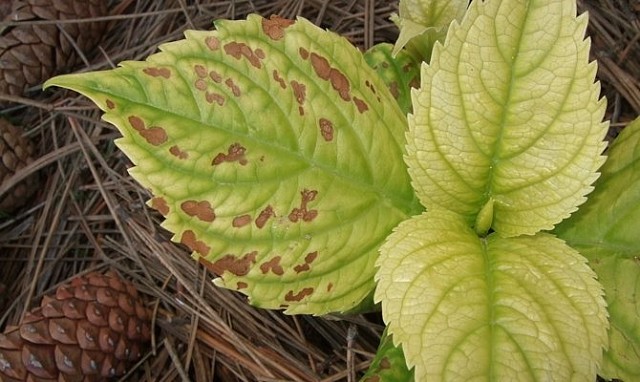
Gardeners reviews
“After reading the reviews, I decided a couple of years ago to plant a Weems Red hydrangea, just looking for unpretentious flowers.I am happy with the result - it blooms profusely and for a long time, the pests do not bother me, I have not been ill with anything yet. "
“I am very pleased with the flowers. The only negative is that due to the periodic acidification of the soil, she was left alone in my flower bed, the other flowers wilted. But I found a way out - I planted other varieties of ortensia next to it. "
The agricultural technology of growing hydrangea Weems Red is simple, even a novice gardener can cope with it. Subject to planting dates, soil requirements and proper care, picturesque flower bushes with a heady smell will bloom in the garden beds, delighting owners from early summer to late autumn.

